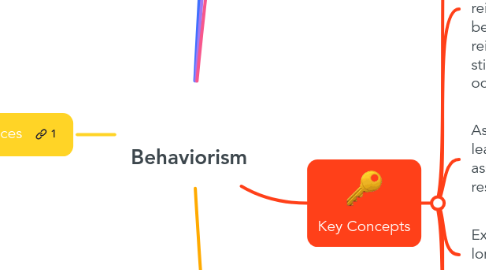Behaviorism
by Melis Dilek

1. References
2. Definition
2.1. Behaviorism is a learning theory that suggests that all behaviors are learned through conditioning, and this conditioning happens through interactions with the surrounding environment. Behaviorists argue that our behaviors are shaped by external stimuli in our environment (Krapfl, 2016).
2.1.1. Methodical Behaviorism: follows Watson’s approach. Deals with only observable and measurable behavior (Powell et al., 2016).
2.1.2. Radical Behaviorism: Associated with B. F Skinner. takes a broader view and includes the study of both observable and unobservable mental processes. It includes operant conditioning which shapes the behavior.
3. Theorists
3.1. John B. Watson
3.2. B.F Skinner
4. Principles
4.1. Behavior must be observable.
4.2. Behavior is learned from the environment.
4.3. All Behaviours are a product of the formula stimulus-response.
5. Key Concepts
5.1. Stimulus-Response: The central concept of behaviorism is the relationship between stimuli (external events or conditions) and responses (observable behaviors).
5.2. Reinforcement: Behaviorism emphasizes the role of reinforcement in shaping and maintaining behavior. Positive reinforcement (rewarding desired behavior) and negative reinforcement (removing aversive stimuli when a desired behavior occurs) are important concepts.
5.3. Association: Behaviorists argue that learning involves forming associations between stimuli and responses.
5.4. Extinction: If a behavior is no longer reinforced, it may become extinct or gradually disappear.
5.5. Generalization: Generalization refers to the tendency to respond to similar stimuli in the same way.
5.6. Classical Conditioning (Pavlovian Conditioning): Two stimuli are associated with each other to generate a novel learned reaction in an individual or animal (Mcload, 2023).
5.7. Operant Conditioning: Operant conditioning establishes a connection between a specific behavior and its resulting consequence, which can be either positive or negative (Cherry, 2023).
6. Application in Online Education
6.1. E-learning modules: Learners interact with online content and receive feedback based on their responses (e.g. MOOC may include these elements)
6.2. Quizzes and Assessments: are often used to reinforce desired learning outcomes by providing immediate feedback.(e.g. language learning applications- Duolingo).
6.3. Gamification: It is widely used in gamification such as badges and points, are used to motivate and reinforce desired behaviors in online learning environments. (e.g) ClassDojo for young learners.


